Cooking with kids
June 7th, 2012
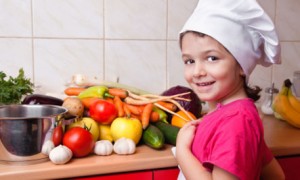 There’s been a lot of debate in the news recently about childcare and government’s role in supporting it. While it’s a complex issue, there’s one point that everyone can agree on – kids can be a real handful, and require a great deal of attention and care.
There’s been a lot of debate in the news recently about childcare and government’s role in supporting it. While it’s a complex issue, there’s one point that everyone can agree on – kids can be a real handful, and require a great deal of attention and care.
One method some stay at home mums (and dads!) use to look after their kids and manage their housework at the same time is to introduce the kids to the kitchen. Having the kids help out with your cooking can help to teach them valuable skills, including teamwork, communication, literacy and numeracy, and it can be a lot of fun for everyone too.
Here are a few tips for looking after kids in the kitchen:
Manage your time
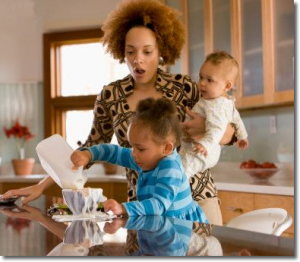 While every child is different, most kids aren’t renowned for their patience or attention span, meaning that even a simple recipe could end up taking three times as long to prepare, especially when you have very small children. It’s not until the kids are older that they’ll be able to properly serve as a time-saving assistant.
While every child is different, most kids aren’t renowned for their patience or attention span, meaning that even a simple recipe could end up taking three times as long to prepare, especially when you have very small children. It’s not until the kids are older that they’ll be able to properly serve as a time-saving assistant.
As time isn’t a luxury that all parents have available, be prepared to use it up when cooking with kids. If you’re spending a Sunday afternoon using cooking as craft activity, you can afford to let the child spend some time experimenting with the effects of flour on everything within reach before showing them how to work the hand-beaters.
But if you’re trying to get dinners on the table on a weeknight, or get breakfasts and school lunches sorted out in the morning, you may need to take control of the operation, and thank the toddlers for providing some purely moral support.
Pick a recipe and keep it simple
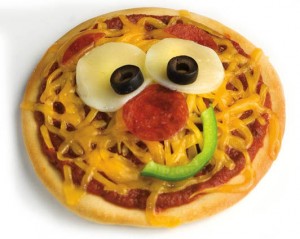 Good things come to those that wait, but kids don’t know that… yet.
Good things come to those that wait, but kids don’t know that… yet.
When you start cooking with kids, try to avoid recipes that involve extensive, time-consuming (aka: “BOOOORING!”) preparation, such as hours of marinating beforehand or resting/cooling afterward. An oven with a fast preheating time, such as one from the ILVE range that heats in 6-8 minutes, can be handy here.
Simple recipes that provide (relatively) instant gratification are probably a better choice, at least until the kids learn to appreciate the finer things. Mini pizzas, tacos and other ‘hands-on’ food are all good choices, and baking is always rewarding – the kids may be able to start learning about patience as they wait for their very own chocolate cake to bake.
Make a plan
 One way to keep the kids on-track while cooking is to involve them in planning the recipe and walking them through its steps. Clearly establishing each stage of the cooking process (measuring, mixing, pouring, baking) and crossing each step off as it is completed will help young children develop their organisational skills.
One way to keep the kids on-track while cooking is to involve them in planning the recipe and walking them through its steps. Clearly establishing each stage of the cooking process (measuring, mixing, pouring, baking) and crossing each step off as it is completed will help young children develop their organisational skills.
Get all of the ingredients out where the kids can see them, as well as any utensils or appliances that you plan to use. Once you’ve been cooking for a while and have your system down pat, you can give the kid-friendly utensils and appliances a home inside a cupboard that’s within arm’s reach for your child, so they can learn to find what they need when they need it, and tidy up after themselves.
Let the kids help out wherever it’s safe
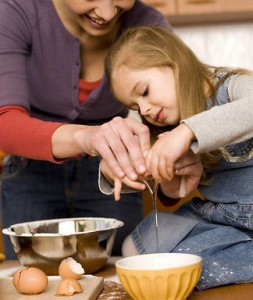 You probably shouldn’t hand your toddler a blowtorch and tell them to get searing that glaze, just like on Masterchef. At a young age, they’re best able to help by adding pre-measured ingredients to the bowl, stirring, greasing pans, and handing over the utensils (once they’re finished covering themselves in flour).
You probably shouldn’t hand your toddler a blowtorch and tell them to get searing that glaze, just like on Masterchef. At a young age, they’re best able to help by adding pre-measured ingredients to the bowl, stirring, greasing pans, and handing over the utensils (once they’re finished covering themselves in flour).
As the kids get older and their cooking skills improve, they should be able to move up to simple tasks like chopping ingredients and operating simple appliances, eventually graduating to more advanced cooking techniques involving hot surfaces.
Always supervise your children while cooking, and be sure to demonstrate proper safety techniques to them, such as chopping away from fingers and turning the handles of saucepans on the cooktop away.
Induction cooktops are very kid-friendly, as their surfaces don’t get hot like electric cooktops and there are no open flames as in gas cooktops, minimising the risk of accidental burns. Plus, they can often get a pot of water boiling in as little as 90 seconds, which is perfect for impatient young cooks.
Promote healthy eating
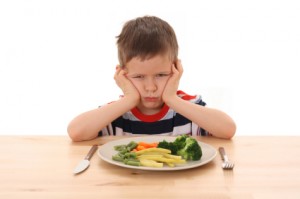 Kids and vegetables don’t tend to instantly get along, but kids that get an early start on the whole ‘eating healthy’ thing are more likely to stick with them until they’re old enough to develop bad habits on their own (‘Cooking with Teenagers’ would be a whole other blog post…).
Kids and vegetables don’t tend to instantly get along, but kids that get an early start on the whole ‘eating healthy’ thing are more likely to stick with them until they’re old enough to develop bad habits on their own (‘Cooking with Teenagers’ would be a whole other blog post…).
By showing the kids what goes into their food as they help to prepare it, they’ll hopefully develop a finer appreciation of nutrition.
One idea is to bring the kids with you to the supermarket and let them pick out their own vegetables – seeing their choices get prepared and transformed into a meal will do wonders. Just steer the trolley clear of the chocolate aisle…
Don’t let the kids forget about hygiene, either. Make sure that hands are washed and messes are cleaned up as you cook.
Have fun!
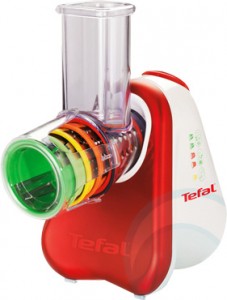 Like we said earlier, every child is different, so tailor your cooking plan to suit what keeps your kids happy while they learn.
Like we said earlier, every child is different, so tailor your cooking plan to suit what keeps your kids happy while they learn.
Certain appliances can make food preparation more fun – just watch the joy on a kid’s face as they see a carrot being sliced by a Tefal Fresh Express, for example. Its also lots of fun to annihilate ingredients into a fine paste with a blender.
What recipes have you cooked with your kids? What have your children learned from spending time in the kitchen?

Leave a Reply